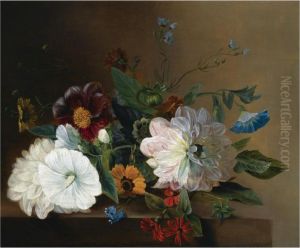Maria Elisabeth Crommelin Paintings
Maria Elisabeth Crommelin, born in 1660 and passing in 1719, was a Dutch artist recognized for her contributions to the field of botanical illustration during the late 17th and early 18th centuries. Her work is an exemplar of the Golden Age of Dutch botany and art, a period when the Netherlands was at the forefront of scientific exploration and artistic expression, particularly in the study and depiction of flora.
Crommelin was born into a time of immense intellectual curiosity and scientific exploration, which was reflected in the Dutch society's fascination with botany and the natural world. This environment nurtured her talents and interests from a young age. Despite the limited opportunities available for women in the sciences and arts during this era, Crommelin pursued her passion for botanical illustration, a field that was becoming increasingly important due to the Dutch involvement in global trade and the introduction of exotic plants to Europe.
Her illustrations were detailed and scientifically accurate, contributing valuable knowledge to the field of botany. Crommelin's work was primarily executed in watercolor, a medium that allowed her to capture the delicate nuances of the plants she depicted. Her illustrations were not only scientifically significant but also aesthetically pleasing, combining artistry with empirical observation.
Unfortunately, like many women artists of her time, Maria Elisabeth Crommelin did not receive the recognition she deserved during her lifetime. Her contributions were often overshadowed by her male counterparts, and much of her work was published anonymously or under the names of male scientists. Despite these obstacles, her illustrations have stood the test of time and are now considered important works in the history of botanical art.
Today, Maria Elisabeth Crommelin is celebrated as a pioneering woman in the field of botanical illustration. Her legacy lives on through her contributions to the understanding of botany and the natural world, and her work continues to inspire both artists and scientists alike. Crommelin's life and achievements reflect the challenges and contributions of women artists in the scientific and artistic endeavors of their times.
